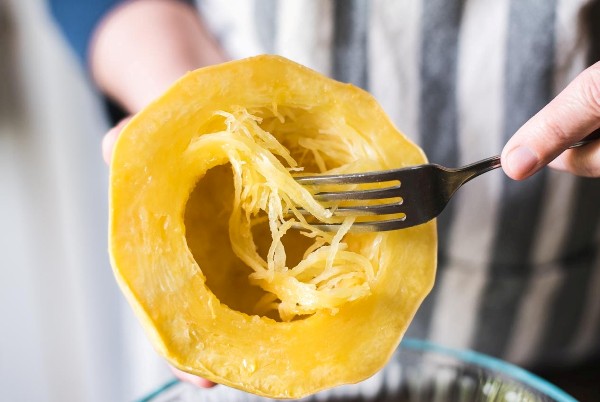Squashes for most summer residents are a popular vegetable. Thanks to modern breeders, gardeners have the opportunity to grow vegetable spaghetti. Externally, this zucchini is no different from other varieties; its pulp is distinguished from the total mass of the varieties.
Table of contents
Description and characteristics of the variety of spaghetti zucchini
Vegetable rich in minerals, vitamins. The fruit of the zucchini has a beneficial effect on blood formation, struggling with cholesterol, have a diuretic effect. They are used for obesity, diabetes.
This vegetable is familiar to few, but vegetable growers who have tested this squash appreciated it.
Popularization of the variety is justified by a number of advantages:
- excellent drought resistance;
- long shelf life;
- unusual appearance;
- rich taste.
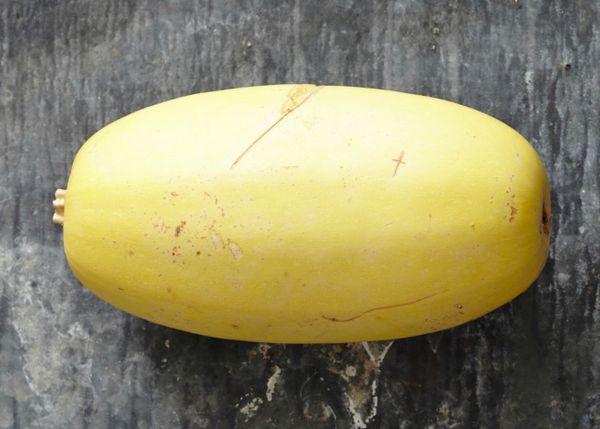
If you cut it in half, you can see the seeds inside, you need to pick them and scrape the zucchini on the pulp. The pulp will begin to separate by the type of vegetable shavings. It may give the impression that the insides of the zucchini were rubbed for Korean carrots.
Nature gave us an extraordinary vegetable in appearance, resembling spaghetti. The peculiarity of this variety - taste is revealed when it fully matures. After heat treatment, it acquires an unusual taste. Raw vegetable spaghetti is added to salads.Due to its excellent lightness, the culture is perfectly preserved until spring.
Mid-late variety - ripening occurs later 95-130 days. Their length reaches 30 cm. As it ripens, it changes color from green to yellow. There are varieties of whitish ripeness. The rind is thick, like a pumpkin. Weight from 0.7 to 1.2 kg. Vegetable growers say good transportability. Grow seeds, at least - seedlings.
Advantages and disadvantages
The reviews on spaghetti are rather ambiguous. Some praise the excellent taste of ripe vegetables, others like the young flesh.
Each vegetable grower has certain advantages and disadvantages:
- In regions where a short summer is a vegetable does not have time to ripen to the state of "noodles".
- Growing fibrous zucchini does not require complex measures, everything happens as in the cultivation of conventional varieties.
- Shrubs love to grow, so they are best grown on high ground.
- Low yield from 1 square. meters collected approximately 5-9 kg per season.
- Due to its features and hard skin, it is stored for a very long time.
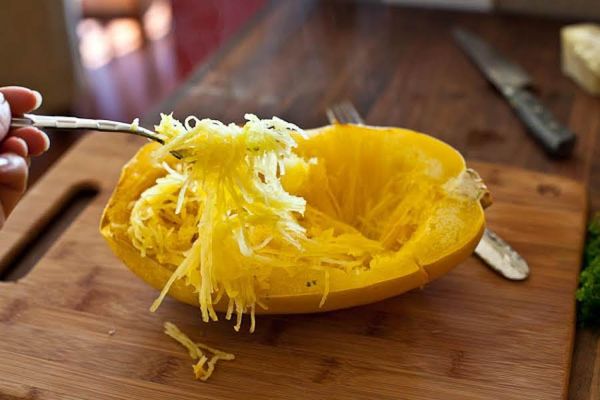
Preparation of zucchini seeds for planting
In most cases, vegetable crops are grown from seeds that can be purchased at specialty stores. Who prefers to mess with seedlings, seeds are planted in cups. Seed preparation and cultivation of spaghetti seedlings are made according to the general rules.
Culture does not impose special requirements, however, some rules must be observed:
- Seeds should be overdue, until planting, you must adhere to the requirements for their storage.
- Seeds can soak for 3-4 days. Moisture will allow them to slip, for this you need to put the seeds in a damp cloth. So that it does not dry out, it needs to be moistened every day.
- If spring is not long, seeds are planted in open ground by the end of May. Otherwise, you need to focus on the temperature of the soil, it must be heated. up to 15 degrees.
- To get an earlier vegetable in maturity, you can plant seeds in a greenhouse. Next, transplant seedlings or open the film so that zucchini grows under natural conditions.

If the origin of seeds is in doubt, they are better. sprout in advanceso you can check for germination.
Soil preparation for cultivation
On hot days, the summer heat and the wind adversely affect the harvest. Therefore it is necessary to choose a bed protected from the wind. It is good if fruit trees grow around.
- the land must advance dug up, loose, fertilized;
- in loam and clogged soil, the culture will develop poorly;
- in addition to properly prepared soil, you need to take care of regular feeding.
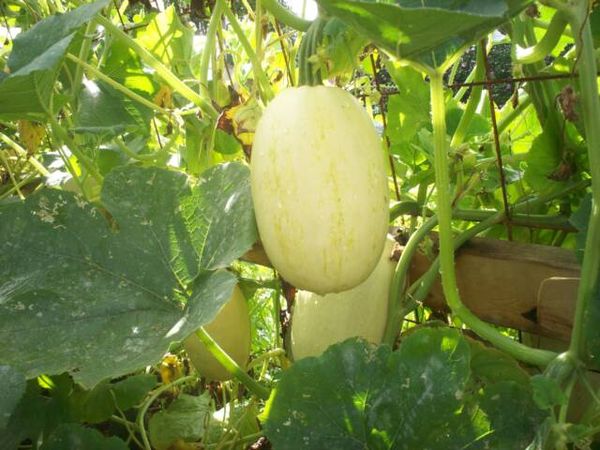
Given the fact that the vegetable ripens for quite a long time, the bushes need to be provided with nutrients throughout the season. Due to the fact that the bushes grow strongly, the seeds are planted over the hills or, conversely, in ditches.
There are cases when they were grown inside the barrels. For this purpose, the barrels are filled with fertile soil and seeds are sown. This method will save space on the beds.
Barrel, braided zucchini, will be an attractive decoration of the infield.
Seed planting technology
Shrubs provide a powerful root system, so the wells do at a considerable distance from 70-90 cm. Seeds are planted dry or after preliminary germination. Well watered, put 1-3 seed there. Sprinkled with earth.
After the germination of sowing produce fertilizing fertilizers, up to this point provide regular watering.
Departure after landing
Watering vegetables is better in the morning or in the eveningwhen the sun goes down 1-2 times a week. Frequent watering will contribute to the growth of greenery, and not the ripening of fruits.
If watered in the heat of the day, you can harm the plant can, burns will appear. Since in most cases zucchini is grown by holes, watering should be done under the root so that the water does not erode the roots.
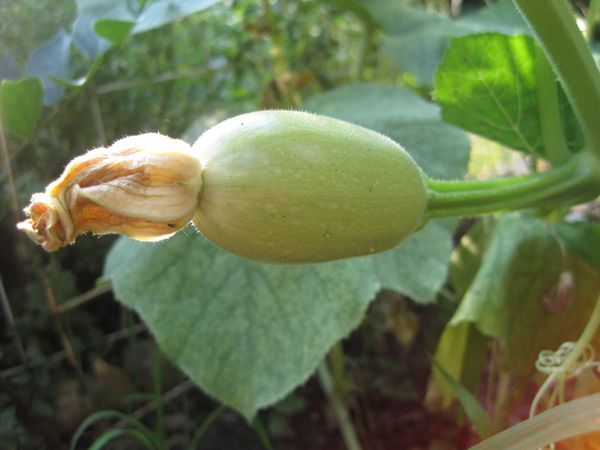
After watering wet soil loosen up - This procedure will enrich the earth with air, will provide breathing to the roots. Spud bushes every 15-20 days. Weeding produce at first, later the bush grows well, the weeds under it usually do not grow.
If the bushes pinch in time, they will be more accurate.
Diseases and their prevention
The most common pest occurs - powdery mildewAs a rule, it infects the leaves.White spots appear on top (mealy patina). At the beginning, these specks are small, if the leaves do not die off from the lesions.
Sprayed with gray colloid at the rate of 100 g per 10 l of water. You can use the infusion of mullein 1: 3. The disease can move from a sick bush to a healthy one, transmitted to other vegetable crops.
Harvesting and storage rules

In this regard, zucchini is more like a pumpkin, this is due to the fact that they are intended for long-term storagetherefore, they hurt longer than others.
The first harvest of young zucchini can be obtained after 25-30 daysafter flowering. Of course, they will be still smaller without a fibrous structure. Some use them that way.
After 2.5-3 months, if the peel of the vegetable is hard, and when tapping, a dull sound is heard - it is time to harvest. Inside the basement can be stored until spring.
It is very good to have several varieties of zucchini in the garden, then the dining table will always be varied.According to the requirements of zucchini spaghetti unpretentious culture. Following the recommendations, you can get a good harvest, even from a small bed. An amazing vegetable will become a favorite in the garden, will delight with its taste and healthy qualities!
